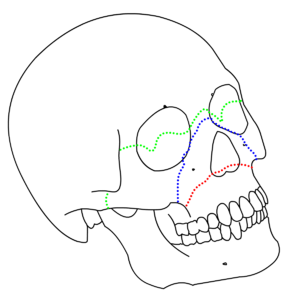Le Fort fractures: Difference between revisions
Neil.m.young (talk | contribs) (Text replacement - "fx " to "fracture ") |
(Text replacement - "fx" to "fracture") |
||
| Line 9: | Line 9: | ||
*Transverse fracture separating body of maxilla from pterygoid plate and nasal septum<ref name="tintinalli"></ref> | *Transverse fracture separating body of maxilla from pterygoid plate and nasal septum<ref name="tintinalli"></ref> | ||
*Only hard palate and teeth move (when rock hard palate while stabilizing forehead) | *Only hard palate and teeth move (when rock hard palate while stabilizing forehead) | ||
*Stable | *Stable fracture | ||
===Le Fort II=== | ===Le Fort II=== | ||
*Pyramidal fracture through central maxilla and hard palate | *Pyramidal fracture through central maxilla and hard palate | ||
*Movement of hard palate and nose occurs, but not the eyes | *Movement of hard palate and nose occurs, but not the eyes | ||
*Can be stable or unstable | *Can be stable or unstable fracture | ||
===Le Fort III=== | ===Le Fort III=== | ||
| Line 20: | Line 20: | ||
*Entire face shifts w/ globes held in place only by optic nerve) | *Entire face shifts w/ globes held in place only by optic nerve) | ||
*Dish face deformity on lateral view | *Dish face deformity on lateral view | ||
*Unstable | *Unstable fracture | ||
===Le Fort IV=== | ===Le Fort IV=== | ||
*Le Fort III plus involvement of frontal bone | *Le Fort III plus involvement of frontal bone | ||
*Unstable | *Unstable fracture | ||
==Differential Diagnosis== | ==Differential Diagnosis== | ||
Revision as of 08:03, 8 July 2016
Background
- LeFort I fractures are isolated to the lower face
- Type II and III injuries[1]
- Associated with cribriform plate disruption and CSF rhinorrhea
Classification
Le Fort I
- Transverse fracture separating body of maxilla from pterygoid plate and nasal septum[1]
- Only hard palate and teeth move (when rock hard palate while stabilizing forehead)
- Stable fracture
Le Fort II
- Pyramidal fracture through central maxilla and hard palate
- Movement of hard palate and nose occurs, but not the eyes
- Can be stable or unstable fracture
Le Fort III
- Craniofacial dysjunction (fracture through frontozygomatic sutures, orbit, nose, ethmoids)
- Entire face shifts w/ globes held in place only by optic nerve)
- Dish face deformity on lateral view
- Unstable fracture
Le Fort IV
- Le Fort III plus involvement of frontal bone
- Unstable fracture
Differential Diagnosis
Maxillofacial Trauma
- Ears
- Nose
- Oral
- Other face
- Zygomatic arch fracture
- Zygomaticomaxillary (tripod) fracture
- Related
Management
- Airway protection
- Consider awake intubation (eg, ketamine) if need airway; if possible do not paralyze a Le Fort for intubation or you may be forced into a crash surgical airway
- Prepare for surgical airway
- CT Face
- Control hemorrhage w/ nasal and oral packing if needed
- Admit for IV abx and sx



